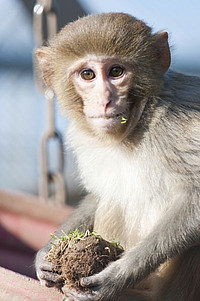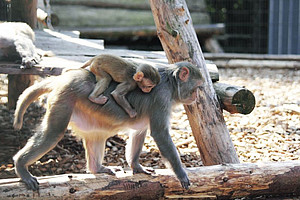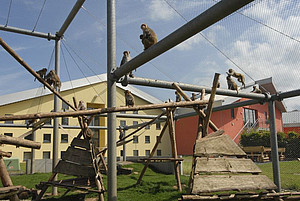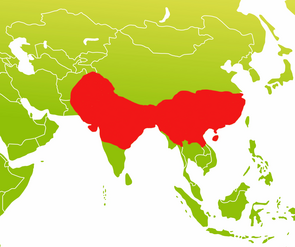Rhesus monkeys
The natural habitat of rhesus monkeys (Macaca mulatta) is Asia and of all primate species they, inhabit the largest area. Their habitat stretches from Afghanistan through India, Thailand, Vietnam and China. Since they are extremely adaptable, they can survive the cold high mountain regions in the Himalayans as well as the dry and hot areas of the plains. Usually, they prefer to live in open scrub, forests and parks. Some rhesus monkey clans prefer rocky areas and coastal marshes as their habitat. In areas where their natural habitat has been increasingly restricted, they live with close range of people, which also speaks in favor of their tremendous sense of adaptability. In South Asia, especially in India, they can be found in rural settlements, temples and even cities.

Diet
Rhesus monkeys are omnivores. Their diet consists mainly of plant material. Their meat diet derives mostly in the form of insects, spiders, crustaceans and bird's eggs. In wetlands, they catch and eat fish. Near human settlements they frequently plunder fields and gardens with grown crops or search garbage cans for edibles.
Lifestyle
Rhesus monkeys are highly vivacious and active animals. They live in groups of 20 to 200 animals and live on the ground or in trees depending on the habitat. They spend most of the day with foraging and eating. Rhesus monkeys run on the ground on all fours and are good climbers and jumpers. They like to bath and are therefore good swimmers. The size of their home ranges is highly variable and could encompass the size of a few hundred meters to several kilometers. Although rhesus monkeys live in group association, they are not very territorial. The individual areas of neighboring groups can overlap significantly but since the outnumbered group rapidly withdraws during confrontations, hostilities are rare.
Social behavior and reproduction
The rhesus monkey groups consist of several males, females and young animals. Hierarchies are formed from in both sexes, whereby those of the females are more stable and lasting than those of the males. The females remain in their birth group, while the males form small bachelor groups and leave the group when they reach sexual maturity. Mating takes place between members of equal ranking in the group. However, the reproductive behavior of rhesus monkeys is characterized by promiscuity. Females reach sexual maturity with three and a half to five and a half years, males slightly later with six and a half years. The mating times vary and are dependent on the habitat. Rhesus monkeys that live in cold-winter areas usually mate in the fall. The infants are therefore born during the spring time. In the lowlands, reproduction is dependent on the monsoon season. Births occur most frequently in the pre - and post monsoon period. (March - June and September - October). After a gestation period of about 166 days, the female gives birth to a baby that weighs between 450 and 500 grams. During the first weeks the infant is carried around on the belly or on the back of the mother who intensively cares for it. After two weeks the infants are ready to take solid food and after six months, it can take care of itself.
Rhesus monkeys in research
Rhesus monkeys have long been used as experimental research animals. In 1940, the rhesus factor, named after them was discovered in their blood. The rhesus factor was later found in humans. This important finding henceforth prevented fatal immune reactions in blood transfusions and during pregnancy. Through experiments on rhesus monkeys, scientists were able to develop the vaccine against the poliovirus in the fifties, where today millions of people are protected from infection. Through the consequent massive export of rhesus monkeys from India to the respective destination countries, their populations decreased rapidly at times. Around the end of the seventies, the Indian government stopped the export of monkeys in order for the population growth to recover. Rhesus monkeys for research are nowadays bred in special facilities such as the German Primate Center with high sanitary standards and are therefore no longer removed from their natural habitat. Worldwide, rhesus monkeys are primarily used as experimental animals in infection research, drug development and in brain research. In 2007, the result of the DNA sequencing of the rhesus monkey genome was published in the journal Science. Followed by humans and chimpanzees, rhesus monkeys are the third fully sequenced primate. The scientists were able to show a 93.5 percent compliance of the rhesus monkey DNA with that of man.
Source: Handbook of the Mammals of the World: Primates (edited by Mittermeier, R.A., Ryland, A.B., Wilson D.E., published by Lynx Edicions, Conservation International, IUCN, 2013)
Profile of the Rhesus monkey
| Scientific Name | Macaca mulatta |
|---|---|
| Taxonomie | Suborder: Family: Subfamily: Tribus: Genus: Species: |
| Habitat | South and Southeast Asia (Afghanistan, Pakistan, India, China, Thailand, Laos, Vietnam, Nepal, Bhutan, Bangladesh, Myanmar, Hainan) |
| Head and body length | 41 - 66 cm 37 - 58 cm |
| Tail size | 12,5 - 31 cm 12,5 - 28 cm |
| Weight | 4 - 14,1 kg 3 - 10 kg |
| Diet | fruits, seeds, blossoms, leaves, shoots, buds, stems, branches, roots, tree bark, mark, rubber, mushrooms, insects, spiders, crabs, crab, fish, shellfish, bird eggs, honey combs |
| Lifestyle | diurnal, mostly found on the ground |
| Social organization | mixed-gender groups, hierachy in both sexes |
| Mating system | promiscuous |
| Life expectency (husbandry) | in the wild; about 25 years |
| Status (IUCN Red List) | least concern |



